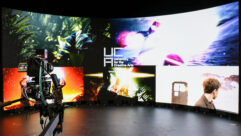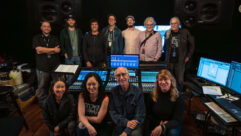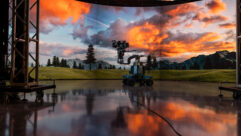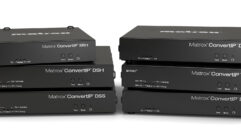
Television Production Systems, Part 1
Aug 10, 2010 12:00 PM
Listen to the Podcasts
|
Editor’s note: For your convenience, this transcription of the podcast includes Timestamps. If you are listening to the podcast and reading its accompanying transcription, you can use the Timestamps to jump to any part of the audio podcast by simply dragging the slider on the podcast to the time indicated in the transcription.
Public Access Television has been around for a good while—getting by on low budgets and sometimes shaky gear—but at Brookline Access TV, they’re doing it like the big guys. Executive Director Peter Zawadzki is here to tell us how he’s using virtual sets, HD cameras, and Broadcast Pix Slate 5000 production systems to put his community on the air waves.
Peter, thanks for being with me here on the SVC podcast. It’s great to have you here from Brookline Access Television. Now, I know public access television has gotten a little bit of a bad rap—you some times have situations where you have shaky gear and maybe people who may not have a lot of production experience in the business, but that doesn’t appear to be the case at Brookline Access Television. Tell me a little bit about that operation and what’s your program line-up like?
Peter Zawadzki: Well, public access really has gotten a bad rap over the years and unfortunately its part of access; there’s access centers that are top-notch production facilities that put out quality programming that can compete with any major network affiliate or PBS station. There’s also other access centers that do produce regular old access programming where Joe Schmo comes off the street and does productions. We’re on the higher end of that; we just built another brand new facility. And we actually went about it in a different way. We looked at public access not where, “Where have we been?” or “What we are,” but “Where can we be and what can we do?” And our space is really designed with that in thought. We have a total of 50 edit stations so we do workshops and trainings in a variety of software—not only video-related but also basic computer training on graphic design, website design. We have two full HD studios. When we’re broadcasting HD, we want to have that available to our higher-end producers. And we do a variety of different things. We have a viewing room, a 25-person seat theater, so we really look at ourselves as more of a technology and community center more than just as an access center. Access is our bread and butter—it’s what we do—but we also look at it as a small portion, more of a department of us than anything else. [Timestamp: 2:44]
When did you get into that facility that you’re in now? And what does it have equipment-wise? It looks pretty fancy to me.
Well, we actually started construction last of June—June 2009, we wrapped up. We had to do construction in two phases because we are in a school building. We took over one entire top floor—10,000 square feet—so we had to do it in phases. The first phase was done over the summer, and we wrapped up in the beginning of September. Phase one has two large computer labs. Each lab has 17 workstations; each work station has [Adobe] CS4, now CS5, [Apple] Final Cut Studio, Blender, Audacity, and a wide variety of different software applications that we use in our own day-to-day operations as well as applications that people request and want to be trained on. Just recently, we installed [Google] SketchUp. We have a group of teenagers coming in and learning how to use SketchUp to help them design a community teen center, so that’s really nice. And then in the education wing we also have an educational studio which has a Broadcast Pix 5000 switcher, we are using Sony [PMW-]EX3 cameras, and we have XDCAM EX record decks, a Yamaha audio board that’s integrated with a Broadcast Pix switcher—which is really nice. It allows one technical director to actually handle the audio if need be, because in a lot of access productions you don’t have a full crew, and when we do have a full crew we can eliminate those macros and run it as just a regular control room, which is nice. And then we have our studio and a set storage. The second phase was completed towards the end of November, and that’s the rest of our space: an individual edit switch with all our Mac Final Cut Pro workstations, a second studio and a second control room, which are carbon copies of each other—which is nice, so when somebody gets trained on one they don’t have to get re-trained on the other. We have our viewing room, conference rooms, We also have a large audio/video system throughout our whole space; we have a total of 14 or 15 LCD displays which are all tied into one central Extron control system, so pretty high-end for an access center. [Timestamp: 4:59]
Related Links

Audio Networks for TV Shows, Part 1
Viewers of the steel cage matches on The Ultimate Fighter TV show may not be thinking about audio networking, but that’s what brings revved up sound from the crowd, the fighters and the announcers. Fernando Delgado of Stickman Sound in Las Vegas takes us backstage for audio networking to go with RockNet…

Worship Video Production, Part 1
Michigan’s Kensington Community Church had to find a way for video production in their main sanctuary and in several satellite locations and make it easy enough to train volunteers to do it fast and right….

The idea is that in the coming decade, someone will have to own the network that AV shares with IT, HVAC, building automation, lighting, etc….
Why did you go with the Broadcast Pix Slate 5000 switchers?
The Broadcast Pix made the most sense to us. Number one, from a price point, in public access—even though we did have a large amount of funds available to us for the build-out—in public access, we are nonprofit, and we have to spend wisely. We have to look at what works well within our budget and what will our users be able to use the most, and the 5000 worked out well. In the price point, it was perfect. It’s expandable if we ever needed to add more inputs down the road, but at the same time it has the CG built into it. It has the clipstore built into it so instead of having to go out and buy a switcher and then add-on all these components, all the components were built-in. It was a great price point, it was an easy installation and configuration, and is very user friendly for—especially the kids coming in who grew up with computers and everything else; it’s just another application for them to use and they pick it up very easily. [Timestamp: 6:02]
Yeah, I made a point about how this was a step up. What was your former facility like?
Oh, goodness. Unfortunately, Brookline Access had gone through several years of downtime. What ended up happening is we were located in a building that was owned by Comcast, and they were moved into a municipal building as a temporary space. That temporary space became almost four years. They were operating out of three old classrooms—no real dedicated spaces, just makeshift cubicles, a makeshift studio—and unfortunately it hurt the organization. And we then had the opportunity to relocate somewhere where we were more central to the town, we were able to involve the youth more, being in the high school. And also with the money that we had, we were able to really build an access center that we hope will become a model across the nation for what access really can become, and that’s a community information and technology training facility. [Timestamp: 7:02]
It sounds like you’re well on your way to that. Now, you’ve got two big HD studios, fairly large. How big are those?
Each studio is—I think it’s about 20’x40′, if not a little bit larger. I don’t have the dimensions in front of me, but they’re fairly large. And what’s also nice about them is we have separate set storage and we’re not occupying room in our studios for that. We have a standard 4×4 grid up with power distribution, and all of our light fixtures are DMX-controllable. We have a DMX control panel in the studio and also wall-mounted in the studio. [Timestamp: 7:36]
Television Production Systems, Part 1
Aug 10, 2010 12:00 PM
And you’ve got Sony PMW-EX3 cameras?
Correct; which is nice because we ended up going with the NIPROS package so we have it running over fiber back to our control rooms with the NIPROS breakout boxes and then also camera control form as well, which is nice. And we ended up going that route instead of a standard studio camera because, in fact, we were already using EX1s for our field acquisition, and we wanted to keep that there. Because we have two studios, we now have the ability to draw gear from one studio or the other if we need additional field gear or if we need additional cameras in one of the studios we can actually take that camera, throw it in the other studio, take the HD SDI out, route it directly into the open Broadcast Pix inputs, and because it is asynchronous, we don’t have to worry about genlocking the cameras or anything else. [Timestamp: 8:30]
You’ve got, I think its Yamaha 01V96 mixers. The Slates control those. How does that control happen?
It’s easy. It’s just—we end up building some scenes … There are two ways of doing it. You can actually tell it to turn individual channels up and down depending on what you select on your program box or preview box, but at the same time you can just launch scenes. And that’s what we ended up configuring is it to slowly launch scenes. And when we actually bring up our XDCAM play deck into program, what it will automatically do is it will automatically fade up the audio channels for that deck. If we bring up a clip store, it will automatically fade up the audio for the clip store. If we fade to black, we can actually fade all the channels, all the mic channels and everything, down. There are some instances where that becomes very handy and helpful like when there is one person doing all the directing, but at the same time, if we do have—especially when we are doing workshops and training, then we have four or five people in there. All we do is we disable that functionality, and then we actually get to have somebody working the audio board as well. [Timestamp: 9:34]
Yeah, probably for the more complex formats you got to have an audio operator.
Well, for a lot of the simple public access shows and stuff like that, the amount of time it saves is great. We’re also doing a lot with macros and other things in the board. [Timestamp: 9:49]
And obviously this all had to be put in by somebody. Who installed all the gear and how did that go?
I actually did all the engineering and all the install of all the gear; it’s actually something I love to do. I’m an executive director/video engineer, and it’s the way I like it and it’s the way I want it to stay. [Timestamp: 10:06]
Well, you certainly don’t have any communication problems between the tech guys, the installers, and the production people then.
No, no. We don’t have any of that. Anytime my staff have a problem or there’s a glitch or anything else, they know where my office is and they come in there and then I’ll go over there and see what the problem is. But at the same time, I like to involve all my staff and make sure all my staff know the ins and outs. There’s a lot of situations—and again, I run my access centers differently. And that’s one of the things about accesses is that every single access center does run differently; there’s no one model that everybody copies. But when I did decide to do all the engineering and all the install and all the configurations, it was not only because it’s something that I enjoy to do, but it’s also helpful for the staff to learn, “OK well this is how this is wired,” and, “This is where this is going.” It teaches them signal path and signal flow, and they better understand how the control room works instead of having this turning key solution and, “There you go—use it.” They may know how to use and operate it, but if there is a problem or if something does need to be changed or done, they don’t know how everything’s wired and configured. This way, they do and it puts them a little bit ahead of the curve. [Timestamp: 11:22]
And I understand you’re using virtual backgrounds there. What are you using those for?
We’re using them for some of our shows. We do have set storage, so we do have plenty of room for sets, but if we have a community producer that comes in and they don’t have the resources to either buy their own sets or they don’t like anything that we have, we give them the option of, “OK well, this is what you can do; we have chroma key sites, and if you want a virtual background, these are what you can do. Or also if you want to create your own, you have that ability too.” You can create something in SketchUp or you can create something in Photoshop or download photos and make your own. And we’ve actually&%151;a lot of our producers have decided to go that route just because it is easier for them and they don’t have to invest any money in sets. [Timestamp: 12:10]
Well, that makes it quick and easy. Now, how do you extend control? You extend control down to Brookline High School auditorium. What happens there?
Actually, what we have is we have another system at the Brookline High auditorium, but we will actually be taking that control over from the separate system there and controlling it over from our educational studio. So we’ve already built in that expandability. So what we’re doing is going to be multiplexing all the data and video over fiber to our location, which is several thousand yards away, and then integrating it into our control room. [Timestamp: 12:48]
Related Links

Television Production Systems, Part 2
At Brookline Access TV, public-access television has moved into the 21st century with macro driven switching, modern lighting systems, and digital mixers…
OK and you’ve got, I think, a separate facility at the town hall?
Correct.
OK, what do you do there? Obviously, I guess town hall meetings and things.
Correct. Your standard municipal meetings, school committee selection, planning board, or if there’s any special or large events going on over there. We have one control room, and we control a variety of rooms in there. Luckily enough, they just remodeled their town hall about two years ago. We have a very good working relationship with the community we’re in, so they called us right away and we were involved right from the beginning, when they were still in working with the architects. So we were able to install our own conduits in the walls. We were able to install all of our own jacks in the rooms that we felt we might need or in the future that we might need, which worked out very, very well for us.
All right, Peter Zawadzki with Brookline Access Television. I appreciate your being here, Peter, for part one. In part two, we’re going to get into some of the graphics and how you do those and how you work with macros and more really interesting stuff. Thanks for being here for part one.
Thank you for having me.










